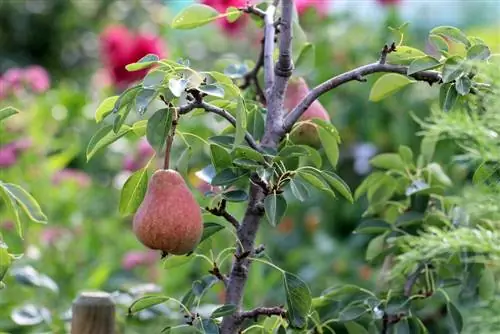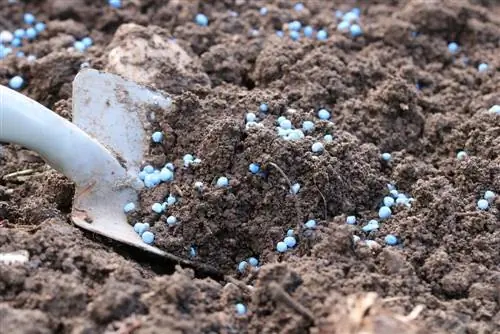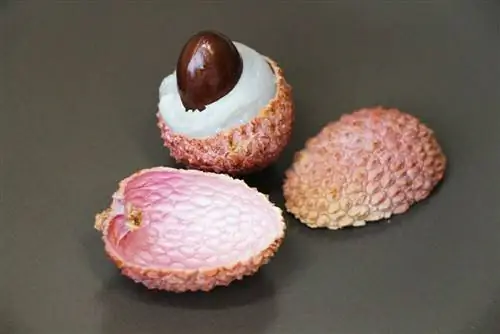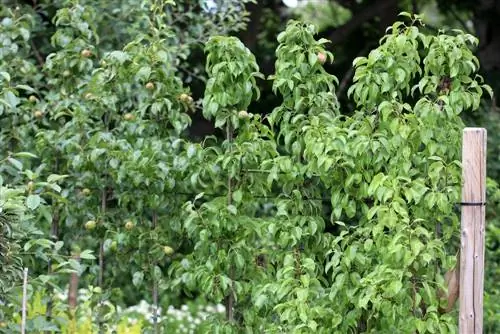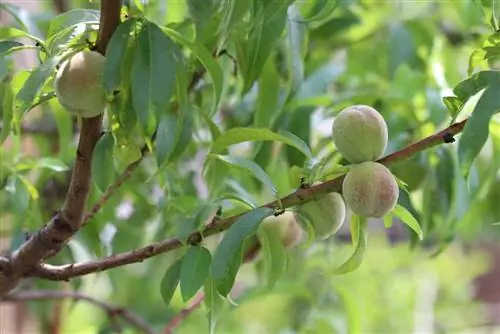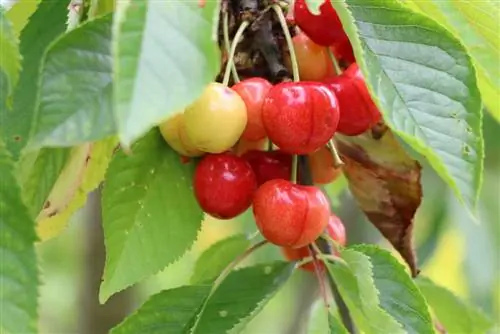- Author admin [email protected].
- Public 2023-12-17 03:39.
- Last modified 2025-01-24 12:45.
Dwarf fruit trees in the garden have long been more than just a trend. They have established themselves as a sophisticated alternative to conventional fruit trees. This shouldn't come as a surprise, after all, the tiny ones have a crucial advantage - they require very little space. At the same time, they bear fruit much faster than their big brothers. The fruits themselves differ little or little. And when it comes to care, no more is required than with conventional fruit trees. A dwarf fruit tree is a very clever alternative.
What exactly is a dwarf fruit tree?
First of all, a dwarf fruit tree is a fruit tree like any other. The fruits it bears are practically no different from the fruits of other trees. The tree growth itself is essentially the same. The only real difference is the size of the plant. A dwarf fruit tree grows to a maximum height of 1.50 meters. As a rule, most dwarf fruit trees range in size from one to 1.20 meters. The reason for this is a genetic change in the genome. In this context, one could also speak of a genetic defect that breeders take advantage of. This short stature naturally means that the harvest quantity is significantly lower. However, nothing changes in the quality of the fruit or the taste. By the way, dwarf fruit trees can also be easily cultivated in a sufficiently large planter.
Varieties
Theoretically, any conventional fruit tree can be turned into a dwarf fruit tree through breeding and genetic modification. In practice, however, the variety selection is relatively limited. The trade usually only offers common varieties. The most popular and therefore most widespread are:
- Dwarf apple Alkmene Linus
- Dwarf Apple Delgrina
- Dwarf pear Helenchen
- Dwarf pear Luisa
- Dwarf Cherry Regina
- Dwarf Cherry Stella Compact
- Dwarf sour cherry Morellini
- Dwarf Peach Bonanza
- Dwarf Plum Imperial
In addition, you can of course find other varieties from regional suppliers. There is now also a quite acceptable variety of varieties in the area of dwarf fruit trees.
Location
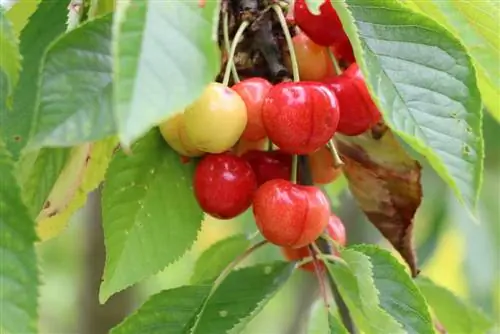
Fruit trees generally love a location that is as sunny as possible. This of course also applies to dwarf fruit trees. Shade or partial shade, however, are not their thing. Sun and warmth play a major role, not least in the development of the tree's fruits. They also influence, at least indirectly, the respective sweetness and flavor intensity. A sunny location in the garden is therefore mandatory - regardless of whether you plant the tree directly in the ground or cultivate it in a pot. If the chosen location is reasonably protected, nothing stands in the way of successful growth.
Soil or substrate
Soil containing humus and clay is ideal for a dwarf fruit tree. Before planting, the soil should be thoroughly mixed with compost again. Fruit trees need a lot of nutrients from the soil to develop their fruits. The richer the soil is, the better it is for the tree. You should especially keep this in mind if you want to plant the dwarf fruit tree in a planter. A mixture of gravel, humus, compost and clay is ideal for this. The gravel's job is to drain away the water. Dwarf fruit trees need a lot of water and have to be watered regularly in the pot, but they don't like waterlogging at all.
Cultivation in planters
As already mentioned several times, dwarf fruit trees are perfect for cultivation in containers. The big advantage is obvious: the tree can easily be moved within the garden if necessary or find space on the terrace. However, it has to be outside. The general requirements for the location always apply. Note: A dwarf fruit tree is not a houseplant! When growing in a container, please note the following:
- sufficiently large planter, capacity of at least 30 liters
- very nutrient-rich substrate
- Pebble insert for better water drainage
- Do not bend or damage roots when planting
- fertilize regularly from spring to August
- repot every three to five years
Basically it can be said that the larger the planter in which it grows, the better the dwarf fruit tree will develop. So it's worth not saving on size here.
Tip:
When purchasing the planter, make sure that the bottom has an opening so that excess water can drain away.
Care
A dwarf fruit tree planted directly in the ground in the garden does not require any more care than a conventional fruit tree. Things look a little different with trees that grow in pots. Regular fertilization is necessary here to ensure an adequate supply of nutrients. Regular watering is also required. If the dwarf fruit tree is on a terrace, you should also be aware that there is usually a different microclimate here than directly in the garden. As a rule, it will be warmer and drier there. Consequently, water supply is of particular importance. Since dwarf fruit trees can react sensitively to night frost, it is advisable to overwinter by covering the base of the tree well with the branches of a conifer.
Cut

Like all other fruit trees, dwarf fruit trees must be pruned if they are to grow as lushly as possible over the long term. Cutting is always done before budding, i.e. until August at the most. The general rules for tree pruning apply. In particular, you should pay attention to the following:
- Cut off branches that grow crosswise, parallel or not outward
- always cut directly above a bud
- Avoid cutting surfaces that are too large or seal them with a commercially available sealing agent
- cut regularly throughout the season
In general, it can be said that the dwarf fruit tree needs to be cut more often than its larger brothers. Proper, regular pruning ensures proper, visually impressive growth. However, the cut should not have a negative impact on the yield. As a rule, you stay away from branches that bear fruit buds or fruit.
Tip:
If you value a lush tree crown with thick branches, you should not cut it over a longer period of time.
Harvest
The dwarf fruit tree is harvested in summer or autumn, depending on the type and variety. The decisive factor is always the degree of ripeness of the fruit. Incidentally, dwarf fruit trees can often be harvested for the first time in the first year after planting. The yield will be limited, but at least it will be much faster than with large relatives. When harvesting, it is of course important to ensure that the fruits are removed as carefully as possible and without damaging the branches.
Flexible with dwarf fruit trees
Dwarf fruit trees can be cultivated extremely flexibly. Their small size makes it easy to harvest delicious fruit even in the smallest garden or on a mini terrace. Even growing on the balcony in the city is basically possible if there is enough sun there. So it's no wonder that the dwarf fruit tree is currently very trendy.

